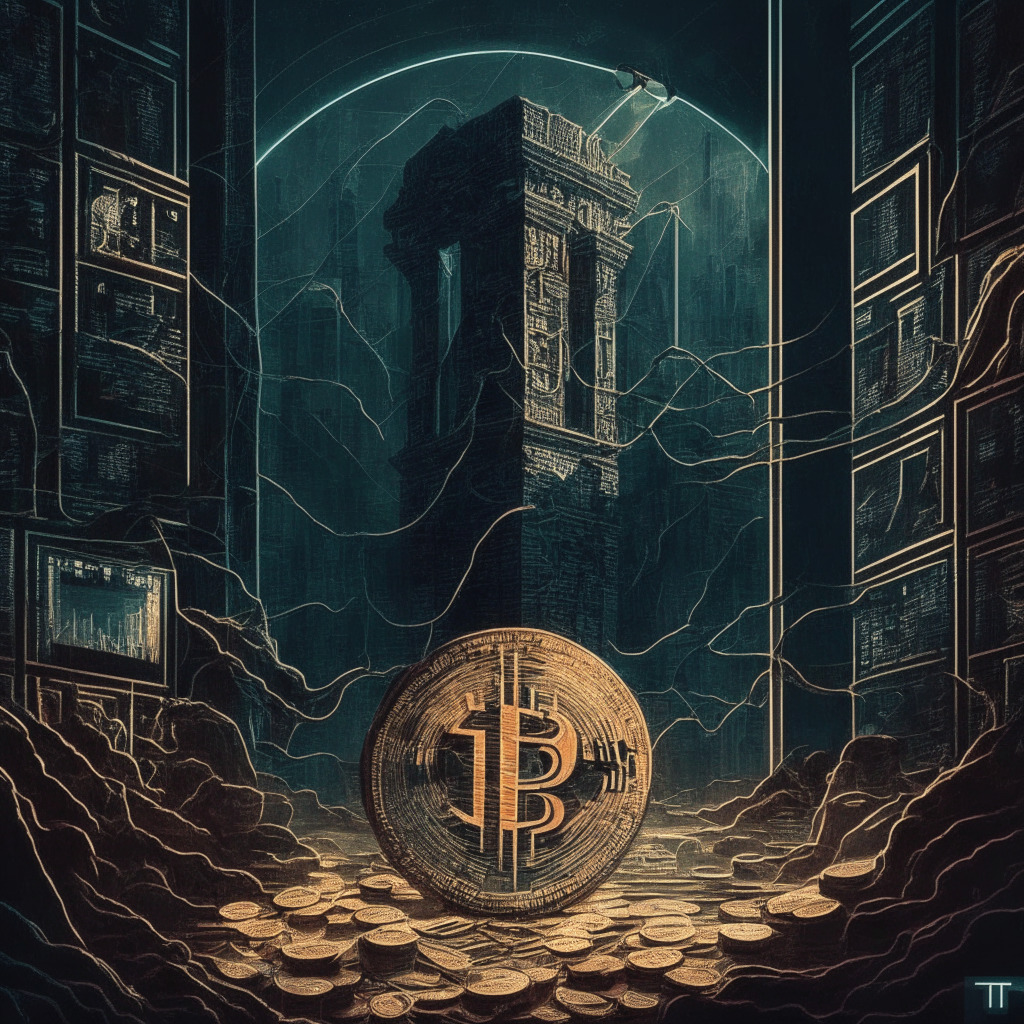“Elon Musk’s social media platform ‘X’ has gained several U.S. payments licenses, potentially bolstering crypto services on the platform. Average trade size for Bitcoin has also spiked, while Binance phases out support for its BUSD stablecoin, impacting the market.”
Search Results for: binance BUSD
BTC Price Defies Predictions; Stability Amid Market Volatility & Future of Stablecoins
“As BTC price holds steady on a 200-day trend line, traders see this as a potential market low. Despite BTC retracting from highs, it hasn’t experienced a total reversal. Other developments in the crypto market, such as Binance’s plans to cease support for its BUSD stablecoin, influence this complex, evolving landscape.”
Blockchain Revolution: Unraveling the Power of Web3 for Financial Sovereignty and Data Privacy
“Blockchain is steering a ‘digital sovereignty’ revolution through the principle of decentralization and Web3. It aims to disrupt conventional infrastructure and restore trust in traditional institutions by combating grave cybersecurity threats and enabling control over personal data. Moreover, blockchain products like cryptocurrency and tokenization could potentially transform our digital interactions and transaction methods.”
Dominating Stablecoin Market: How Tether Maintains Its Leadership Despite Regulation Tests
“Tether maintains its dominant position in the stablecoin market despite competition and regulatory challenges. With total assets at $86.1 billion, it demonstrates economic robustness, outpacing competitors such as USD Circle, and shows growing appeal among investors while weathering recent regulatory fines and market events.”
Tether’s Stablecoin Reign: Surmounting Regulatory Scrutiny, Market Competition, and Financial Accusations
“Tether’s market capitalization stands at $86.1 billion, with total assets exceeding liabilities, signifying stability and dominance over its competitors. Despite facing regulatory scrutiny and skepticism, Tether remains popular among investors due to its transparency and surplus reserves.”
Crippling $1 Billion Crypto Liquidation: Markets in Turmoil, Caution Urged
“A sudden slump in Bitcoin and Ether prices caused a frenzy in the cryptocurrency market, leading to large-scale liquidations and a loss of estimated $1B. As per Coinglass, 176,752 traders got liquidated within 24 hours. Market volatility, macroeconomic conditions, and range-trading tendencies have contributed to this downturn. Despite potential rewards, the inherent risks underscore the need for thorough research before investing.”
Navigating Uncharted Waters: PayPal’s Foray into Stablecoin with PYUSD
“PayPal is venturing into cryptocurrencies with its own stablecoin, PayPal USD (PYUSD), which aims to reduce volatility. Despite competing with established stablecoins in a volatile market, PYUSD’s compatibility with future Web3 applications and PayPal’s reputation could grant legitimacy to the crypto industry.”
The SEC’s Crypto Crackdown: Necessary Oversight or Innovation Barrier?
“Bittrex agreed to a $24 million settlement following SEC allegations of operating as an unregistered securities exchange, part of an acceleration of SEC’s enforcement on disruptive crypto firms. The aggressive regulation is critiqued for thwarting investment and innovation, pushing the industry to more amiable jurisdictions like UAE or UK.”
Decoding CZ’s Take on Stablecoins: Bridging Transparency and Regulatory Challenges
Binance CEO Changpeng Zhao discussed the complexities and regulatory challenges of Stablecoins, amid growing uncertainties around major Stablecoins like Tether. To counter these uncertainties, Binance is fostering partnerships with varied Stablecoin projects and creating region-specific algorithmic Stablecoins, balancing innovation, regulatory compliance, and risk management in the evolving Stablecoin ecosystem.
Digital Assets in War: Analysing Ukraine’s Crypto Boost amid Russian Conflict
Ukraine has benefited from the decentralized nature of cryptocurrencies amid the Eastern European conflict, with $225 million worth flowing into the country for essentials such as weaponry and medical supplies. Despite slowing donations, financial backing persisted. Notably, most contributions geared towards humanitarian initiatives than military operations. USDT emerged as the primary donation currency, followed by Ether, Bitcoin, and others. Contrastingly, Russia’s crypto fundraising has been lesser and subtle. Technology and economic strategy in crisis times aren’t free from potential manipulations and concealed transactions.
Stablecoins’ Struggle for Dominance Amid Market Turbulence: A Chronicle of Ups and Downs
The recent downturn in crypto markets has led to a decreased dominance of stablecoins, with the Pax Dollar (USDP) facing a significant decrease. Despite an overall reduction in the stablecoin market, there has been a surprising increase in stablecoin trading volumes. This turbulence in the crypto space continues to influence the stablecoin market.
The Rise and Uncertainty of Centralized Stablecoins: Balancing Transparency and Dependence
Centralized stablecoins, stabilizing their price against another asset like the U.S dollar, account for 75% of all transactions on centralized crypto exchanges, with TrueUSD (TUSD) and Tether’s USDT taking significant shares. However, amid growth, controversies and transparency issues pose challenges and risks, demonstrating the crypto market’s vulnerability. The future of such stablecoins depends on addressing these vulnerabilities and embracing transparency.
Diving into Celsius Network’s Shift: Liquidation Concerns and the Ripple Effect on Crypto Markets
Celsius Network, a struggling crypto-lending firm, has alarmed investors by transferring $70 million in altcoins to various wallets following a court order. This move sparks fears of a massive sell-off and potential market volatility. Amid this, crypto consortium Fahrenheit aims to acquire Celsius, amidst increasing regulatory scrutiny in the broader crypto landscape.
Unmasking the Cross-chain Protocol Loopholes: The $42 Billion Illusion Attack and the Future of Blockchain Security
Attackers reportedly exploited the cross-chain protocol of PolyNetwork’s bridge tool, minting billions of tokens on different blockchain platforms to create an illusion of a ballooned wallet. However, lack of liquidity ultimately prevented them from capitalizing on this ill-gotten wealth. This incident highlights the need for vigilant security in the blockchain ecosystem.
Trader’s $4M Short on TUSD: Analyzing Stablecoin Stability Amid Issuer Challenges
A trader took a $4m short position on stablecoin TrueUSD (TUSD) after its issuer temporarily halted mints and redemptions through banking partner Prime Trust. This highlights the importance of vigilance among cryptocurrency enthusiasts, as regulatory scrutiny and operational challenges can affect the value and stability of digital assets like TUSD.
SEC Crackdown on DeFi and Stablecoins: Analyzing Pros, Cons, and Market Implications
The SEC is potentially targeting decentralized finance (DeFi) and stablecoins, including Tether (USDT) and USD Coin (USDC), in its enforcement crackdown, according to a Berenberg report. Stablecoins, essential to the DeFi ecosystem, have raised national security concerns due to weak sanctions and money laundering controls. The SEC aims to weaken DeFi’s capacity to rival regulated exchanges and lenders.
Bitcoin Dominance Surges: Impact on Altcoins and Future of Crypto Market
Bitcoin’s market cap surpasses all other cryptocurrencies combined, reaching over 50% dominance, a level unseen since May 2021. Factors include regulatory scrutiny on altcoins, SEC lawsuits, and increased Bitcoin adoption driven by institutional investors and clearer regulations.
Hong Kong vs US: Stablecoin Regulations by 2024 – Opportunities and Challenges Ahead
Hong Kong and the US aim to introduce stablecoin regulations by 2024, focusing on investor protection and fostering a conducive environment for crypto enthusiasts. Hong Kong has taken the lead in crypto regulations while the US House Committee is working on draft stablecoin bills.
Impact of SEC Lawsuits on Crypto Market: Analyzing Volatility and Affected Tokens
The SEC lawsuits against Coinbase and Binance have impacted crypto markets, causing certain tokens like SAND, ALGO, ADA, BNB, FIL, MATIC, CHZ, ATOM, and ICP to drop 10-18% in value. Skepticism surrounds the SEC’s reasoning, with claims of technical misunderstandings. Traders should tread cautiously with affected tokens as market fluctuations persist.
SEC’s Cryptocurrency Securities Criteria: Uncertainty and its Impact on the Industry
The US SEC’s recent lawsuits against Binance and Coinbase have raised concerns about criteria used to determine which cryptocurrencies are considered securities. Market capitalization of these “crypto securities” exceeds $100 billion, yet clear regulations are lacking, leading to uncertainty about the future of crypto in the United States.
TerraClassicUSD Repegging: Revitalizing LUNC and Impact on Blockchain Future
The Terra Classic (LUNC) core developer team Joint L1 Task Force (L1TF) plans to work on TerraClassicUSD (USTC) repeg to $1 after the v2.1.0 parity upgrade is approved. The community unanimously passed Proposal 11548 “USTC Test Environment” on June 7, reflecting the project’s significance. This initiative aims to revitalize LUNC and restore utility to the Terra Classic blockchain.
Crypto Safe Havens Amid SEC Scrutiny: Memecoins and Eco-Friendly Projects on the Rise
Despite the recent SEC regulatory uncertainty, crypto prices are rising, with Bitcoin, Ether, and meme coins like Dogecoin and Shiba Inu among the beneficiaries. Investors may be shifting towards cryptocurrencies considered safe havens against regulatory risks, as continued development and investment in the US crypto sector promote adoption.
Solana (SOL) in SEC Crosshairs: Impact on Price and Alternatives for High-Risk Crypto Investors
The SEC has labeled Solana (SOL) as a security amid lawsuits against Binance and Coinbase. SOL’s price dropped 10% and may face delisting from US exchanges. Despite the uncertainty, alternative high-risk crypto investments like yPredict’s $YPRED token presale emerge as attractive options.
Exploring Factors Behind Terra Luna Classic’s 35% Rally: Delisting, Upgrades, and Shorts Liquidations
Terra Luna Classic (LUNC) price has skyrocketed by 35% due to Binance’s upcoming delisting of the USDⓈ-M 1000LUNCBUSD Perpetual Contract and the recent release of v2.1.0 upgrade proposal for Terra Classic blockchain. This surge is driving bullish price movement, with traders increasingly going long on LUNC.
Tether’s USDT Reclaims All-Time High Market Cap Amid Stablecoin Controversy and Competition
Tether’s stablecoin USDT has regained its all-time high market cap of $83.2 billion, despite challenges in the stablecoin market and criticism over its reserve transparency. USDT’s perceived safety from U.S. regulators and its growing use for global payments contribute to this resurgence, highlighting peg stability as a priority for users.
MakerDAO Drops USDP: DeFi Stability Concerns & Avenues To Maximize Revenues
MakerDAO’s community vote unanimously decided to eliminate the $500 million USDP stablecoin from its reserves, impacting Paxos and raising concerns about the stability of some stablecoins within the crypto ecosystem. The decision aims to increase revenues and improve the protocol’s capital efficiency.
Stablecoin Market Shifts: USDT Reigns Supreme as USDC Fumbles with Regulation
The market dominance of stablecoins has shifted, with Tether’s USDT hitting an all-time high and Circle’s USDC experiencing a downturn. Increased transparency is emphasized for stablecoin reserves, while Tether and Circle reduce banking exposure amid economic uncertainty and increase US Treasury holdings.
Stablecoin Market Contraction: Implications for Crypto Liquidity and Recovery Prospects
The stablecoin market’s contraction for the 14th consecutive month signals a potential liquidity issue within the digital asset ecosystem. This decline may impact cryptocurrency prices, and analysts believe that sustained crypto market recovery might not occur until the stablecoin decline is curbed.
Whales Shift from Bitcoin to Altcoins and Stablecoins: Future Market Dynamics at Play
While Bitcoin’s trading volume and liquidity are dropping, whales have shifted their focus to accumulating stablecoins and lesser-known altcoins such as Porspoer $PRO, Banqi $QI, and Maker $MKR. Stablecoins like USD Coin, Binance USD, and DAI Stablecoin have seen increased whale interest, indicating future buying power.
Tether’s USDT: Surging Market Cap and Falling Trading Volume – What’s the Catch?
Despite Tether’s USDT stablecoin market cap surging to $83.4 billion, its trading volume has experienced a sharp decline, falling below $10 billion for the first time since March 2019. This trend raises questions about the stablecoin’s actual usage and brings concerns about USDT’s value and lack of audits back to the surface.
Stablecoin Dilemma: Market Contraction Threatens Crypto Recovery and US Debt Ceiling Issue
The stablecoin universe’s ongoing contraction, impacted by U.S. regulatory crackdowns and other challenges, hinders hopes of a sustained crypto market recovery, says a JPMorgan research report. Stablecoins’ struggles pose far-reaching consequences for the entire crypto ecosystem, and overcoming these obstacles is crucial for long-term growth and security.
Tether’s 15% Bitcoin Investment: Pros, Cons, and Future of Stablecoin Regulation
Tether plans to invest 15% of its net profits in Bitcoin to strengthen and diversify its reserves, demonstrating the company’s confidence in the cryptocurrency market. As US lawmakers discuss potential stablecoin legislation, Tether’s bold move could potentially shape the future of the industry.































